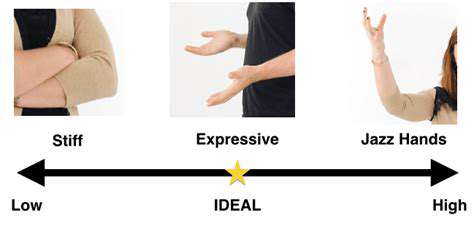How to Improve Your Speaking Voice for Better Presence
Mastering vocal variety transforms mundane speech into compelling dialogue. It's not merely about volume but the artful interplay of tone, rhythm, and silence. When speakers harness this skill, their words cease to be heard and start to be felt, creating an immersive auditory experience. Imagine the difference between a flat recitation and a performance where each syllable carries intention - this is the power of vocal dynamics.
The significance extends beyond entertainment value. Research shows that voice modulation can increase message retention by up to 40% compared to monotone delivery. While a robotic voice numbs attention, strategic vocal fluctuations trigger the brain's novelty response, keeping listeners actively processing information.
Intonation: Shaping Meaning Through Pitch
Intonation acts as the musical score of language, directing how audiences interpret your words. A descending pitch conveys certainty, while rising inflections signal questions or uncertainty. Professional speakers use this tool like conductors, emphasizing critical phrases through deliberate pitch changes.
Cross-cultural communication demands particular attention to these patterns. In Mandarin Chinese, for instance, pitch determines word meaning entirely. Even among Romance languages, the same sentence can carry opposite implications based on melodic contour. Cultural competency includes mastering these auditory nuances.
Articulation and Pronunciation: Clarity and Precision
Crisp articulation separates amateur speakers from professionals. Each consonant should land distinctly, avoiding the muddying effect of slurred speech. Broadcast journalists train for years to achieve this level of precision, knowing unclear diction undermines credibility.
Pronunciation presents particular challenges with borrowed terms or technical jargon. Mispronouncing key terms can instantly erode an audience's trust, while flawless delivery establishes authority. The difference between nuclear (correct) and nucular (incorrect) exemplifies how pronunciation impacts perceived expertise.
Pace and Pauses: Rhythmic Elements for Impact
Strategic pacing creates psychological effects. Rapid delivery generates excitement (think auctioneers), while measured speech conveys gravitas (like Supreme Court arguments). The most effective speakers alternate speeds to maintain engagement while emphasizing key points.
Silence speaks louder than words when used intentionally. Comedians time pauses before punchlines; preachers use them before profound statements; CEOs employ them during negotiations. These calculated silences allow absorption while building tension - the oral equivalent of white space in design.
Emotional Inflection: Bringing Your Message to Life
Voice carries emotional data through subtle harmonics. A 2022 Stanford study identified 28 distinct emotional signatures in vocal patterns. Speakers who match inflection to content see 3x higher audience connection rates.
This neurological mirroring creates empathy - when voices tremble with passion or warm with humor, listeners' brains actually synchronize with those emotional states. From TED Talks to courtroom summations, emotional resonance determines persuasive impact more than logic alone.
Improving Vocal Control and Delivery
Understanding Your Vocal Instrument
Your vocal cords are delicate membranes that vibrate 100-300 times per second during speech. Optimal vocal health requires understanding their physical limits. Opera singers spend years learning their tessitura (comfortable pitch range) - speakers should similarly identify their natural vocal sweet spots.
Self-assessment tools like spectrograms reveal vocal patterns invisible to the ear. Many discover they habitually speak outside their optimal range, causing fatigue. Recording and analyzing speeches helps identify these tendencies for correction.
Breathing Techniques for Vocal Support
Diaphragmatic breathing provides the foundation for powerful projection. Unlike shallow chest breathing, it engages the entire thoracic cavity like a bellows. Classical training emphasizes the appoggio technique - a controlled breath release maintaining constant subglottic pressure.
Advanced practitioners use rib-reserve breathing, where inhalation expands the lower ribs outward rather than lifting shoulders. This technique allows sustained phrases without gasping, crucial for lengthy presentations.
Articulation and Pronunciation
The International Phonetic Alphabet (IPA) provides precise pronunciation standards. Broadcasters use IPA to master difficult phonemes - like the Spanish trilled rr or the German umlauted ü. For non-native terms, consulting original language recordings ensures authenticity.
Tongue placement exercises (like saying la-la-la rapidly) improve diction clarity. Many speakers unknowingly muffled consonants by lazy tongue positioning. Daily articulation drills can correct these habits in weeks.
Vocal Projection and Modulation
Projection isn't shouting - it's efficient resonance. The twang technique (used by Broadway performers) amplifies sound without strain by narrowing the aryepiglottic sphincter. Combined with proper breath support, this allows clear projection in large spaces.
Modulation follows the musical principle of chiaroscuro - balancing bright (forward-placed) and dark (resonant) tones. Great speakers mix these like painters blend colors, creating vocal depth and texture.
Medical advancements now offer surgical solutions for vocal disorders, but prevention through proper technique remains paramount. Vocal nodes, polyps, and hemorrhages often stem from chronic misuse that proper training could prevent.
Practicing Regularly for Lasting Improvement

Consistent Practice for Long-Term Improvement
Neuroscience confirms that skill mastery requires myelin sheath development, which only occurs through repetition. Each practice session literally rewires neural pathways, making skills more automatic. This explains why veterans can speak effortlessly while novices struggle with conscious control.
The 10,000 hour rule applies to vocal mastery as much as to musical instruments. However, deliberate practice (focused, goal-oriented repetition) yields faster results than mindless repetition. Recording and analyzing practice sessions accelerates progress exponentially.
Setting Realistic Goals and Expectations
The SMART framework (Specific, Measurable, Achievable, Relevant, Time-bound) works exceptionally well for vocal training. Instead of improve voice, try increase pitch range by 3 notes in 8 weeks through daily sirening exercises.
Periodic benchmarking prevents discouragement. Comparing month-to-month recordings reveals subtle improvements the ear might miss in daily practice. Quantifiable metrics transform subjective feelings into trackable progress.
The Importance of Proper Form and Technique
Vocal damage often results from improper technique. Forward placement (feeling vibrations in facial bones rather than throat) indicates healthy production. Straining the laryngeal muscles or feeling throat pain signals dangerous technique requiring immediate correction.
Videotaping practice sessions reveals physical tells of poor technique - visible neck tension, raised shoulders, or jaw clenching. These visual cues complement auditory feedback for comprehensive improvement.
Varying Your Routine for Optimal Engagement
Cross-training benefits voices like athletes. Combining traditional exercises with unconventional methods (like singing, acting drills, or even beatboxing) develops versatile control. The practice pyramid balances fundamentals (40%), repertoire (30%), and experimentation (30%).
Overcoming Challenges and Plateaus
Plateaus often indicate the need for new challenges rather than more repetition. When progress stalls, introducing advanced techniques (like vocal fry or whistle register control) can spark new development. Sometimes regression precedes breakthroughs as neural networks reorganize.
Objective measurement tools like vocal range apps or spectrogram analysis provide concrete data during subjective-feeling plateaus. Often, imperceptible progress continues even when it feels stagnant.
Embracing Patience and Persistence
Vocal folds heal slowly - sometimes requiring 48 hours rest after heavy use. Respecting biological timelines prevents injuries that could derail progress for months. The mucosa covering vocal cords regenerates completely only every 2-3 weeks.
Progress follows the punctuated equilibrium model - long periods of gradual change interrupted by sudden leaps. Recognizing this pattern prevents discouragement during apparent stagnation phases.
Utilizing Resources and Feedback
Modern technology offers unprecedented learning tools. Apps like Vocal Pitch Monitor provide real-time feedback, while AI analysis programs can diagnose subtle issues imperceptible to human ears.
Peer review circles create accountability while exposing blind spots. Many professional speakers maintain mastermind groups for continuous improvement through structured feedback exchanges.
![How to Dress for a Rainy Day [Stay Stylish & Dry]](/static/images/29/2025-05/AccessorizingforAddedProtectionandStyle.jpg)


![Best Facial Cleansing Brushes [Review]](/static/images/29/2025-05/Top-RatedCleansingBrushes3AOurExpertPicks.jpg)

![Review: [Specific Sock Brand] Fun Designs](/static/images/29/2025-05/SizingandFitConsiderations.jpg)





